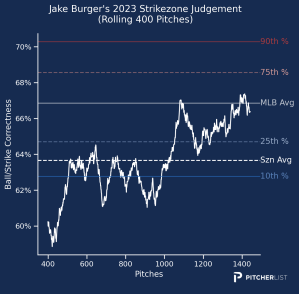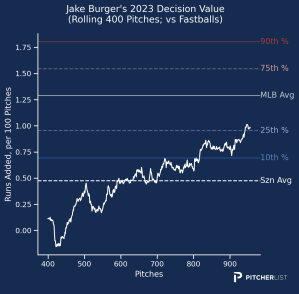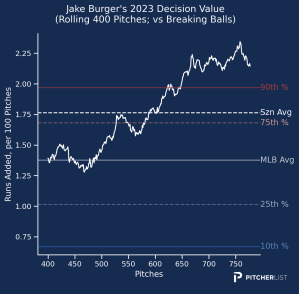The “sleeper” label in fantasy baseball terms can be nebulous. For many, it can be players to target going late in drafts. It can also mean a player that is being underdrafted. I subscribe to the latter definition, as I believe a sleeper to be a player who is being relatively undervalued by the fantasy baseball industry. Sleepers, in my eyes, are not guaranteed to, but will more likely than not, exceed our preseason expectations when the games begin to count.
Third base is a position where I’m choosing to target players later in drafts because there is a plethora of options available that I believe will outpace their projections and their draft position. Don’t get me wrong; the top tier is appealing in its own right, but the opportunity to focus on other positions while waiting on third base presents itself because the players being drafted outside the top 150 picks are so enticing.
The middle tiers of players that man the hot corner have a shot at performing much closer to the secondary tiers of third basemen than the current ADP is suggesting. Past that, numerous exciting breakout candidates are being drafted after pick 200. Focusing on just a few players to target can be difficult with dreams of breakouts accompanying dozens of third basemen. It’s important to do so, though, because it allows you to build a draft strategy around targeting some of the sleeper options that are more tantalizing than their peers.
It’s time for fantasy managers to wake up and realize that the following third basemen are being undervalued in drafts this spring.
All ADP data has been taken from NFBC Draft Champions drafts since the new year.
Hamburger jokes: tired. Suggesting this third baseman has an 80-grade first name: wired. I’ve been touting Burger’s abilities all offseason. It began in September when I anointed him as the Marlins’ best player in the second half. I then doubled down by mentioning him as a hot second-half hitter that deserves our attention. My convictions have not died down since then and I’ve backed them up by drafting him in my BARF league draft earlier in February.
The appeal in Burger’s profile extends far beyond his power prowess and begins with his abilities as a contact hitter. A mid-season acquisition for the Marlins, Burger improved his batting average by nearly 90 points (from .214 to .303) after leaving the South Side of Chicago and slashed his strikeout rate by almost 10% (from 31.6% to 21.7%). On the surface, it seems like the Marlins helped him alter his approach to become more contact-oriented, but that sentiment would be misleading. Burger actually began making the change before heading to Miami and we only saw the fruits of his labor in the second half due to his sample size being reset.



The right-handed hitter’s strike zone judgment improved as his season-long decision values on both heaters and breakers improved. This suggests that he was conscious of his struggles, made the correct adjustment to big-league pitching, and subsequently performed at a level that should stick in 2024.
Drafters may be wary of the decline in his power numbers in the second half, but it’s not something I’m worried about. He hit 25 homers in pinstripes but just nine in whatever word you’d use to describe the Marlins’ jerseys. The lack of home runs was accompanied by a 6.5% decrease in his Statcast-measured barrel rate (from 19.6% to 13.1%). This obvious decrease in power production doesn’t bother me because Burger’s batted-ball metrics were still well above average. That second-half barrel rate would’ve still been in the top 30 in baseball had it stuck for the entire year. Additionally, I much prefer Burger as a .250 hitter with 30 home runs than I do as a .220 hitter with 40 dingers.
Jake Burger > Dodger Dog pic.twitter.com/Qm61MPueM8
— Miami Marlins (@Marlins) August 19, 2023
That former projection is right in line with the consensus between my three most trusted projection systems: Pitcher List, ATC, and The BAT X. Still, this is an article about sleepers who will outperform expectations; Burger needs to outproduce those numbers if he’s to live up to my hype. At his projected level, he’ll perfectly match the production expected from a player with his ADP of 156.3 (13th 3rd Basemen), but if we consider the fact that his contact improvements are stickier than his full-season xAVG (.243) would suggest, then we can project him more as a .260-.270 hitter with 30+ HR power. On top of that, he’s projected to bat cleanup for the Marlins, presenting him with plenty of plate appearances and run-producing opportunities.
I’ve been targeting Burger around pick 150 – right where the ADP has him. However, the production I expect of him is much closer to that of Nolan Arenado (.265 AVG, 27 HR) who is going off the board as the ninth third baseman with an ADP of 106.9. That doesn’t mean you need to draft Burger inside the top 100 to get him, but it does display the fact that you may be wasting valuable draft picks on a player that will provide you with similar production to one you can find 50 picks later. Stop sleeping and order a #36 at the takeout window (I couldn’t resist).
If you thought I’ve written a lot about Burger this offseason, Hayes has him beat. He was labeled (by me) as the best player on the Pirates in the second half and was mentioned as a hot second-half hitter that deserves our attention. I also wrote about how he was finally attaining his full potential in August. I even paired him with Burger in my BARF league draft. So as much of a Burger fan as I may be, my adoration for Hayes might even trump that.
The slick-fielding third baseman caught my eye when he finally started hitting the ball over the wall after the All-Star break. When I dove into his underlying metrics, I realized he had finally made the change for which the fantasy industry and Pirates fans alike had been awaiting anxiously since his debut in 2020.
Just like Vladimir Guerrero Jr. and Yandy Díaz before him, Hayes displayed the potential for power but was held back by a tendency to hit the ball on the ground. What I found when I did my deep dive was that Hayes had finally gotten the ball in the air and to the pull side. Even more importantly, he had been doing it all season and we just didn’t see the results until he returned from a lengthy injury-related absence in August. The plate approach alteration paid massive dividends as the 10 homers Hayes hit in the second half would’ve been a single-season career-high by themselves. If you’d like to read more into the minutiae of his transformation, check out the first article I wrote about him in August.
Now, we’ll get to see a full season of the new and improved Hayes and it should have fantasy managers pumped. However, that hasn’t really been the case as Hayes is being drafted as the 14th third baseman with an ADP of 165.7. Not everyone’s sold on him. I guess they haven’t been keeping up with my articles, but hey, that means smart fantasy managers will benefit from others having yet to buy in.
Ke’Bryan Hayes EVs this spring:
105.7
105.4
105.1
104.3
91
🔥
pic.twitter.com/JGyYYIYJob— Chris Clegg (@RotoClegg) February 27, 2024
What makes Hayes so appealing as a third base target outside of his newfound power is that he’s a unicorn at the position. He combines that power with speed (projected for 15+ steals) that’s difficult to find in a third baseman and he hits the ball hard (eighth-best hard contact rate) so consistently that he’s all but guaranteed to provide a batting average that will help you sleep at night. On top of that, he’s expected to lead off for the Pirates and will maintain an everyday role (health permitting) due to his platinum-caliber glove. That should afford him a boatload of plate appearances and an accompanying plethora of runs.
At the pace he set last year, Hayes can be a .270 hitter with 20 long balls and 15 swipes, above his current projection of .265/15/15. If he continues to improve as a hitter, I could see him reach a ceiling of .285/25/20 which would make him one of the game’s biggest breakouts and an absolute steal of a draft pick. As a unique baseball player, there are no direct comparisons for Hayes.
His ceiling is equal to the projections for José Ramírez (.275/27/25) while his 50th percentile outcome is close to what Spencer Steer (.255/20/9) is projected to produce. Jo-Ram is obviously a best-case scenario and is going off the board as the first third baseman with an ADP of 15.1 (so I guess Hayes has the potential to be the best third baseman if he exceeds all expectations). However, even the more realistic comparison of Steer (11th 3B, 114.2 ADP) is being drafted well ahead of Hayes. If you miss out on the elite options, don’t fret, because there’s one more elite option waiting for you after pick 150.
Every year there’s a player that is considered a sleeper that everyone’s in on. Players who align with those criteria are wide-awake sleepers. Garcia fits that description perfectly. His 2023 didn’t particularly stand out despite swiping 23 bags while batting north of .270 because it came with just four long balls. Garcia has the same profile as pre-breakout Hayes in that he displays an innate ability to hit the ball hard but has yet to find a way to put those balls in the air. It’s easy to dream of a player of his ilk as we have witnessed so many hitters make the necessary changes to reach their power potential.
Garcia sported the ninth-best hard contact rate in the majors in 2023 yet paired it with a barrel rate south of 3.5% (12th percentile). He hit the ball on the ground 53% (88th percentile) of the time leading to under 22% (third percentile) of his batted balls being labeled as fly balls. Additionally, he pulled fewer than 32% (sixth percentile) of his batted balls. In a situation like this, all we can do is cross our fingers and pray that Garcia and the Royals work together to inject loft and pull to his swing. Even without an increase in pulled fly balls, Garcia will still provide production that will outproduce his creeping ADP.
Drafted as the 19th third baseman with an ADP of 215.3, Garcia brings contact and speed to the table which is difficult to deny. Projection systems believe he’ll get close to repeating the .272 average he reached in 2023 and suggest that he’s a threat for another 20-steal campaign. Below is the complete list of players with at least 500 plate appearances, a hard-contact rate north of 33%, and double-digit steals in 2023.
| Name | HC% | SB | AVG |
| Ronald Acuña Jr. | 42.3% | 73 | .332 |
| Michael Harris II | 36.8% | 20 | .293 |
| Ke’Bryan Hayes | 36% | 10 | .271 |
| Julio Rodríguez | 35.1% | 37 | .275 |
| Maikel Garcia | 35.1% | 23 | .272 |
| Juan Soto | 34.8% | 12 | .275 |
| Bobby Witt Jr. | 34.3% | 49 | .276 |
| Fernando Tatis | 33.7% | 29 | .257 |
| Gunnar Henderson | 33.5% | 10 | .255 |
| Mookie Betts | 33.2% | 14 | .307 |
| Average | 35.5% | 27.7 | .281 |
The average xAVG of this group was north of .277. Not only is Garcia in great company, but this list also proves that he should be guaranteed at least a .270 batting average because of his hard-hit ability and his wheels. We can also take into account the fact that the average home run total of the nine other players was 29 and suggest that Garcia is due for more than the four he hit in 2023. He’s a clear outlier in the power department amongst hard-contact merchants and places himself amongst the elite fantasy contributors with his speed.
This may be a player we have to revisit next offseason because sometimes the changes to hit fly balls can take a couple of seasons. We saw that happen with Guerrero Jr., Diaz, and Hayes. However, if Garcia makes an immediate tweak and can eclipse double-digit dingers, we’re looking at an elite fantasy talent. If he bats .270 with 10 long balls and 20 steals, his production would be similar to that of Hayes. If he reaches an even higher level and flirts with .300 while launching balls over the wall at a 15-home-run pace while increasing his steals total to 25-30, he’ll be a legitimate first-round candidate next Spring. We can’t dream too hard though, and if his more realistic projection of .266/7/21 is what happens in 2024, he’ll still live up to his ADP despite not living up to the hype.
Maikel Garcia is a tweak away from being a steal in 2024 drafts.
– Above-average plate discipline metrics
– 50.6% HH, 91.8 mph EV, 73rd% sprint speed
– Needs to trim the GB%Early 2024 ADP: 231 (3B 21)#FantasyBaseball pic.twitter.com/EFzweAokcO
— Eric Cross (@EricCross04) November 29, 2023
Garcia’s currently a Hayes-lite with the potential of even surpassing his position mate because of his elite speed. Don’t get too sucked into his sleepiness and dream of a potential first-round-caliber player, but keep in mind that he could break out in full if he makes that one obvious change to his plate approach.
With so much love for the first three players, it leaves little room for me to target anyone else at the hot corner. Chapman earned my admiration last year when he underperformed his expected metrics so dramatically in the first half, that it led to me labeling him as the third baseman to target in the second half. Somehow, he performed worse in the second half and made me look a little foolish.
Now, he remains an unsigned free agent, and yet, he’s retained my attention. A lot of that has to do with his depressed ADP of 274.9, which makes him the 24th third baseman off the board, though it also has to do with his impressive batted ball profile and his history of success. The draft position is just icing on the cake at this point.
Chapman is one of the best barrelers in baseball. Among players with at least 400 plate appearances, his Pitcher List-measured barrel rate of 16.3% was fifth in all of baseball, trailing only Aaron Judge, Shohei Ohtani, Yordan Alvarez, and J.D. Martinez. Weirdly enough, it only led 17 home runs. Edouard Julien is the next player on the barrel rate leaderboard with fewer home runs (16) than Chapman in 2023. Julien had just a 13.1% barrel rate and 174 fewer plate appearances. No player (min. 400 PA) with a barrel rate north of 15% had fewer than 20 home runs and no player with at least 500 plate appearances with a barrel rate above 11% had fewer than 20 home runs. Chapman clearly and generously underperformed in the home run department for a player with his batted-ball quality.
Bat Chapman💣
VOTE: https://t.co/DwPiRk3RP2 pic.twitter.com/YHjBMZTo3s
— Toronto Blue Jays (@BlueJays) June 11, 2023
Not only was Chapman an outlier among his peers, but he was also an outlier compared to his previous career norms. Despite sporting the best barrel rate of his career, he fell well short of his career high of 36 homers in 2019. If we attribute that total to the juiced ball, his identical 27 home run campaigns from the previous two seasons also easily eclipse his 2023 moonshot tally. While Chapman has fallen off as a contact hitter, he’s at least been able to maintain his affinity for the long ball.
Projection systems are joining me in buying in on a Chapman bounceback. The consensus is a season in which he produces a .236 batting average with 25 home runs and four chip-in steals. That batting average will hurt you a little, but his production is not very different from that of Max Muncy (projections: .226/28/2). That becomes important when you consider the fact that Muncy is being drafted as the 17th third baseman with an ADP of 183.2. Muncy has the benefit of being in a deadly lineup while we’re still unsure where Chapman will set up shop, but that’s built into the ADP difference. Chapman should also be guaranteed an everyday role when he finds a home due to his elite defense at the hot corner. If you’re looking for consistent and reliable power after pick 250, Chapman is your man. Draft him now before he signs and his ADP skyrockets.
Moncada never truly lived up to the hype cast upon him as a minor leaguer. He’s had a couple of electric seasons (2019: 5.5 fWAR, 2021: 4.0 fWAR) but has failed to perform and stay on the field consistently. On top of that, his elite plate discipline makes him more suited for points leagues. These factors have led to him almost completely dropping off the standard fantasy baseball radar.
I’m a believer that Moncada will bounce back in 2024 and I’m more than willing to take the chance on it because of his heavily depressed ADP. He’s being drafted as the 35th third baseman with an ADP of 374.9, giving him ample room to provide excess value above his draft position. However, he’ll have to hit much better than did in 2023 to make that happen.
The switch-hitter batted .260 with just 11 dingers and one measly steal as he struggled with injuries and ineffectiveness all year. Those ailments and his slump held him back as his plate discipline metrics were all out of wack. A player with a career walk-to-strikeout ratio of 0.35, Moncada walked less than ever and struck out more than he has in a full season since 2018, leading to a 0.19 walk-to-strikeout ratio in 2023. Just having a normal offseason and a healthy regular season should be enough to get him back to his patient ways.
Yoán Moncada SMASHED that baseball. #WorldBaseballClassic pic.twitter.com/EVLHgezedf
— Chicago White Sox (@whitesox) March 12, 2023
A more successful path forward at the plate is apparent. Moncada barreled the ball at his highest rate since 2019, helping him sport a slugging percentage not seen since his 2019 breakout. If he carries that over, he’s got a shot at eclipsing 20 home runs for just the second time in his career. Additionally, he was one of the best hitters in terms of ideal contact rate (91st percentile) and proved adept at making contact on swings (swinging-strike rate of 14.4%, 77th percentile). The former suggests a hitter that’s better than the below league-average wRC+ (98) he posted last year while the latter points to a player that wasn’t deserving of a 30% strikeout rate.
It seems as though projection systems are in agreement that Moncada isn’t cooked. While they don’t predict a return to his 2019 form, a renaissance season looks to be on the horizon. The consensus projection for Moncada is .244/18/2 – numbers that don’t particularly stand out. However, after pick 350, that’s gold. Especially considering he’s penciled in as the cleanup hitter for the White Sox. Outside the top 250 picks, it’s almost unheard of to find a player projected to hit inside the top five of a lineup, let alone the top four. Below are the third basemen being drafted between picks 250 and 400 accompanied by their projected spot in the lineup according to Roster Resource.
| Name | ADP | Lineup Spot |
| Matt Chapman | 274.9 | — |
| Eugenio Suárez | 275.8 | 6 |
| Willi Castro | 298.5 | Platoon/Bench |
| Jordan Westburg | 313.2 | 9 |
| Colt Keith | 316.8 | 6/Platoon |
| Wilmer Flores | 338.1 | 6 |
| Tyler Black | 346.2 | Minors |
| Ezequiel Duran | 350.8 | Platoon/Bench |
| Michael Busch | 351 | 7/Platoon |
| Brett Baty | 362.2 | 8/Platoon |
| DJ LeMahieu |
363 | 1 |
| Yoán Moncada | 374.9 | 4 |
| Chris Taylor | 385.4 | Platoon/Bench |
Moncada and LeMahieu are the clear outliers on this list and the latter is at risk of losing his job to Oswald Peraza. A spot at the top of the order guarantees a player tons of plate appearances (health permitting) and can provide run-producing opportunities no matter how poor the surrounding hitters. Moncada is due to aid fantasy teams in the runs and RBI department even if he doesn’t improve dramatically in the average or home run categories.
With all of that being said, Jeimer Candelario (20th 3B, 217.8 ADP) is projected for a .252 average with 20 home runs and five stolen bases. Incredibly similar to Moncada’s projection while coming with a 157-pick premium. That makes Moncada a stand-out target extremely late in drafts and doesn’t even account for the possibility of improvements at the plate. If he maintains his .260 batting average while reaching the 20 home run potential he hinted at with his 2023 barrel rate, he could be a player that provides top-150 pick value out of a player being drafted with one of your final picks. Moncada is one of the best veteran fliers hidden amongst a pile of high-upside youngsters, so take the chance on a player who’s already proven he can make it at the big league level.
Photos by Icon Sportswire | Adapted by Justin Redler (@reldernitsuj on Twitter)


I believe the word you’re looking for to describe the Marlins uniforms is cromulent. They’re a perfectly cromulent uniform.